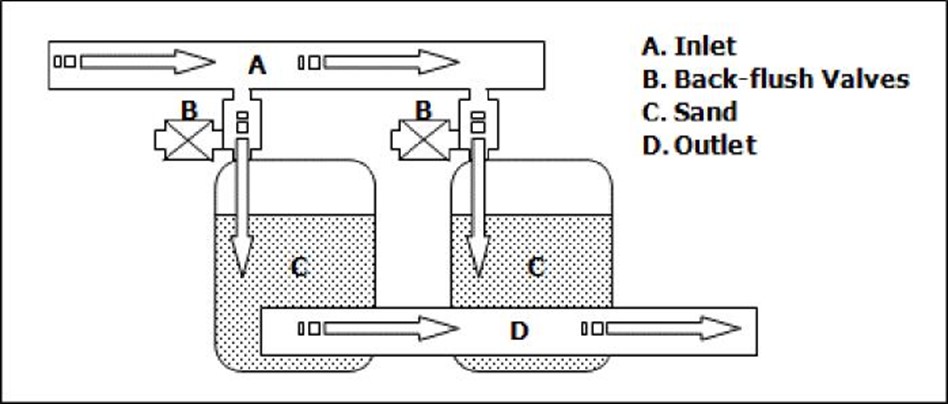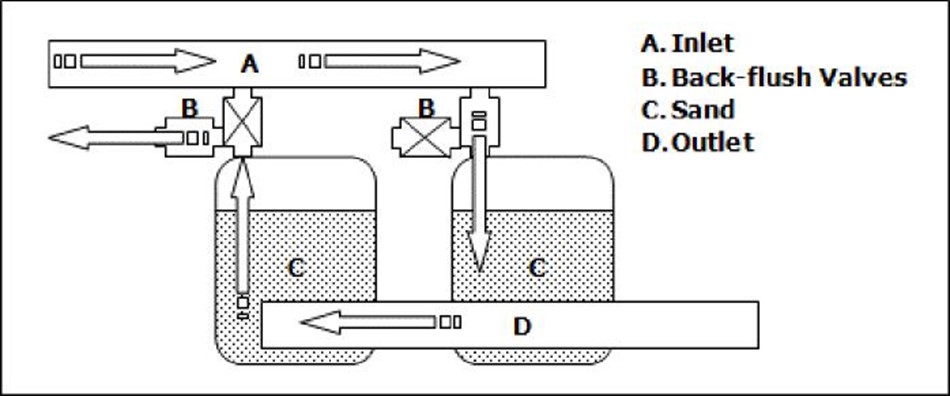Flushing and Cleaning Filters
Primary filters are usually in banks and can be either sand or disc filters.
Filters in banks are back-flushed using hydraulic valves. In a sand filter, water enters through the inlet and is filtered through the sand during normal operation with back-flush valves closed. The clean water exits through the outlet and the dirt and impurities stay trapped in the sand. The more the filter is used, the dirtier the sand will become.

Normal Filtration in Sand Filter
If the sand has become dirty to a point where water cannot pass through it easily any longer, a pressure differential between the in- and outlet of greater than 0.5bar occur. The filter needs to be back-flushed.
If filters are not back-flushed regularly in the prescribed manner, dirt will accumulate in the filter, causing holes in the sand. The accumulated dirt causes irregular flow inside the filter. This irregular flow blow holes inside the sand. The water will move through the holes and not the sand, meaning that the water will not be filtered properly.
Filters are flushed up to five times a day or even more, depending on the water quality. It is good practice to also flush the filter once a week with the main valve closed. This will create extra pressure to flush out the filter. Once a month the filter lid must be opened and the inside inspected. Remember not to do this while the filter is under pressure. Check that the sand is loose and not caked. Caked sand will not break up during backflush, so the dirt stays inside the filter. If the sand is caked, report it to the manager.
The filters in the bank are flushed one at a time. During the back-flush, the inlet of the filter is closed, and the back-flush valve is opened. Clean water from the other filter flows back through the filter that is being flushed. The dirt is washed out with the wastewater. The filter must be flushed for no less than 60 seconds. If the water is brown and muddy, it is a good indication that the filter is doing its job. Flushing must continue until the water is clear.

Back-flushing of Sand Filter
Disc filters use discs to filter water instead of sand. If the filters are in a bank, they can be back-flushed in the same manner as sand filters. If the filter is a single inline type, it can be cleaned by removing the filter element or cartridge, as follows:
- Loosen the filter element.
- Remove the individual discs.
- Scrub each disc with a brush and water.
- Replace in the same way and with the same amount in the filter element.
- Reinsert the filter element into the filter.
- Close the lid.
The filter elements are removed and cleaned on a weekly to monthly basis, depending on water quality.
Pipeline Maintenance
Leaks in pipes, connections and flanges must be repaired as soon as they are detected. Basic repair and replacement items must be kept on the farm for this purpose.
It is important to flush the mother lines and lateral lines regularly. The intervals between flushing vary depending on the season, being weekly in mid-summer and monthly in winter. Proper flushing reduces emitter blockage and forms an essential part of the maintenance program. The supervisor or manager will prescribe the appropriate flushing interval.
Tool Maintenance
Proper care and maintenance of tools prolong their lifespan and will help to ensure that they work properly. Follow these guidelines:
Hand Tools include pliers, spanners, screwdrivers, spades and any other hand tools. After use, wash, clean and dry the tools if required, otherwise wipe them with a rag. Regularly following this procedure will prevent rusting. When tools are dry and clean, store them in the proper place that prevents theft and accidents.
Pressure Gauges – Keep gauges away from high temperatures and protect them from bumps and shocks. If the gauge is filled with fluid, keep it 3/4 full of glycerine. Never use a low-pressure gauge to measure high pressure as this will damage the gauge and make it inaccurate.
Grease Guns and Oil Cans – Keep grease guns and oil cans free of sand and grit. Always wipe the tip of the grease gun before use to remove any sand or grit. Wipe off excess grease and oil after use, and after filling the cans.
Tools must be stored in a shed or an enclosed area that can be locked. This prevents the theft of tools. A system must be in place to ensure that tools are returned after being used. It is helpful to have designated areas for the different tools marked on a board, to which the tools can be returned. This not only keeps the tool shed tidy but allows one to see at a glance if a tool is missing.
Reporting
Using defective tools and equipment can be very dangerous and costly. It is good practice to learn to be sensitive to the tools and equipment you use. Usually, there is a symptom before a breakdown or problem occurs, for example, a pump will make a noise or vibrate if something is wrong, or the secondary filters will need cleaning within a shorter period of time because something is wrong with the primary filter.
It is very important that worn, defective tools and equipment be reported to the manager. Any unusual events or problems must also be reported to the manager.